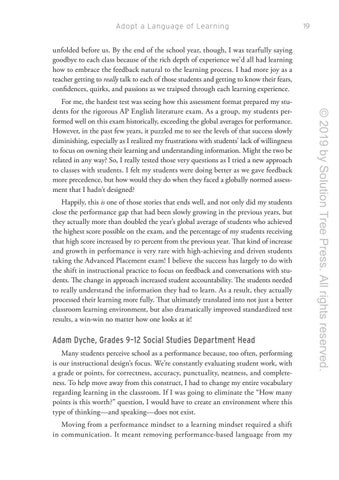Adopt a Language of Learning
19
unfolded before us. By the end of the school year, though, I was tearfully saying goodbye to each class because of the rich depth of experience we’d all had learning how to embrace the feedback natural to the learning process. I had more joy as a teacher getting to really talk to each of those students and getting to know their fears, confidences, quirks, and passions as we traipsed through each learning experience.
Happily, this is one of those stories that ends well, and not only did my students close the performance gap that had been slowly growing in the previous years, but they actually more than doubled the year’s global average of students who achieved the highest score possible on the exam, and the percentage of my students receiving that high score increased by 10 percent from the previous year. That kind of increase and growth in performance is very rare with high-achieving and driven students taking the Advanced Placement exam! I believe the success has largely to do with the shift in instructional practice to focus on feedback and conversations with students. The change in approach increased student accountability. The students needed to really understand the information they had to learn. As a result, they actually processed their learning more fully. That ultimately translated into not just a better classroom learning environment, but also dramatically improved standardized test results, a win-win no matter how one looks at it!
Adam Dyche, Grades 9–12 Social Studies Department Head Many students perceive school as a performance because, too often, performing is our instructional design’s focus. We’re constantly evaluating student work, with a grade or points, for correctness, accuracy, punctuality, neatness, and completeness. To help move away from this construct, I had to change my entire vocabulary regarding learning in the classroom. If I was going to eliminate the “How many points is this worth?” question, I would have to create an environment where this type of thinking—and speaking—does not exist. Moving from a performance mindset to a learning mindset required a shift in communication. It meant removing performance-based language from my
© 2019 by Solution Tree Press. All rights reserved.
For me, the hardest test was seeing how this assessment format prepared my students for the rigorous AP English literature exam. As a group, my students performed well on this exam historically, exceeding the global averages for performance. However, in the past few years, it puzzled me to see the levels of that success slowly diminishing, especially as I realized my frustrations with students’ lack of willingness to focus on owning their learning and understanding information. Might the two be related in any way? So, I really tested those very questions as I tried a new approach to classes with students. I felt my students were doing better as we gave feedback more precedence, but how would they do when they faced a globally normed assessment that I hadn’t designed?


